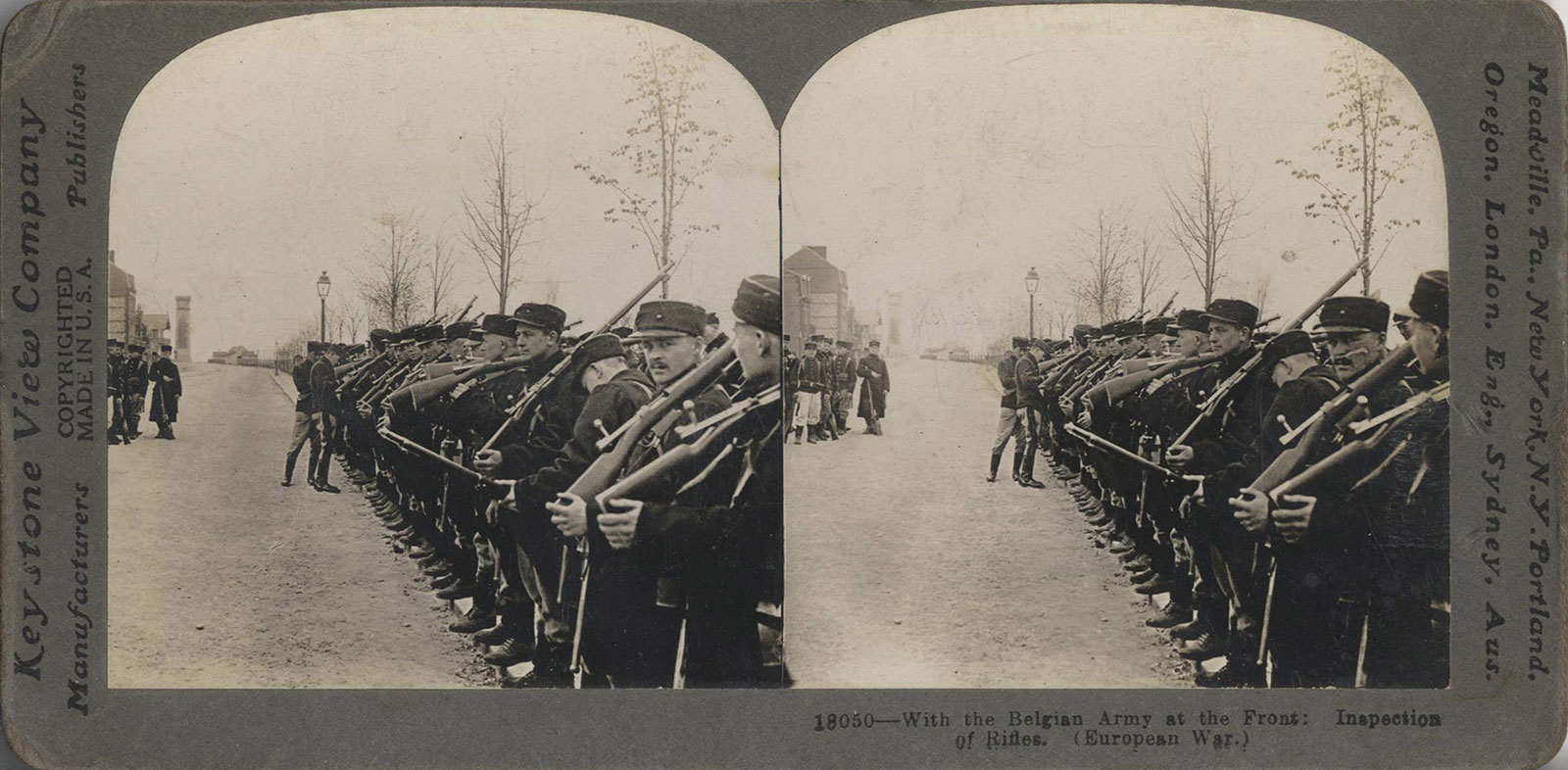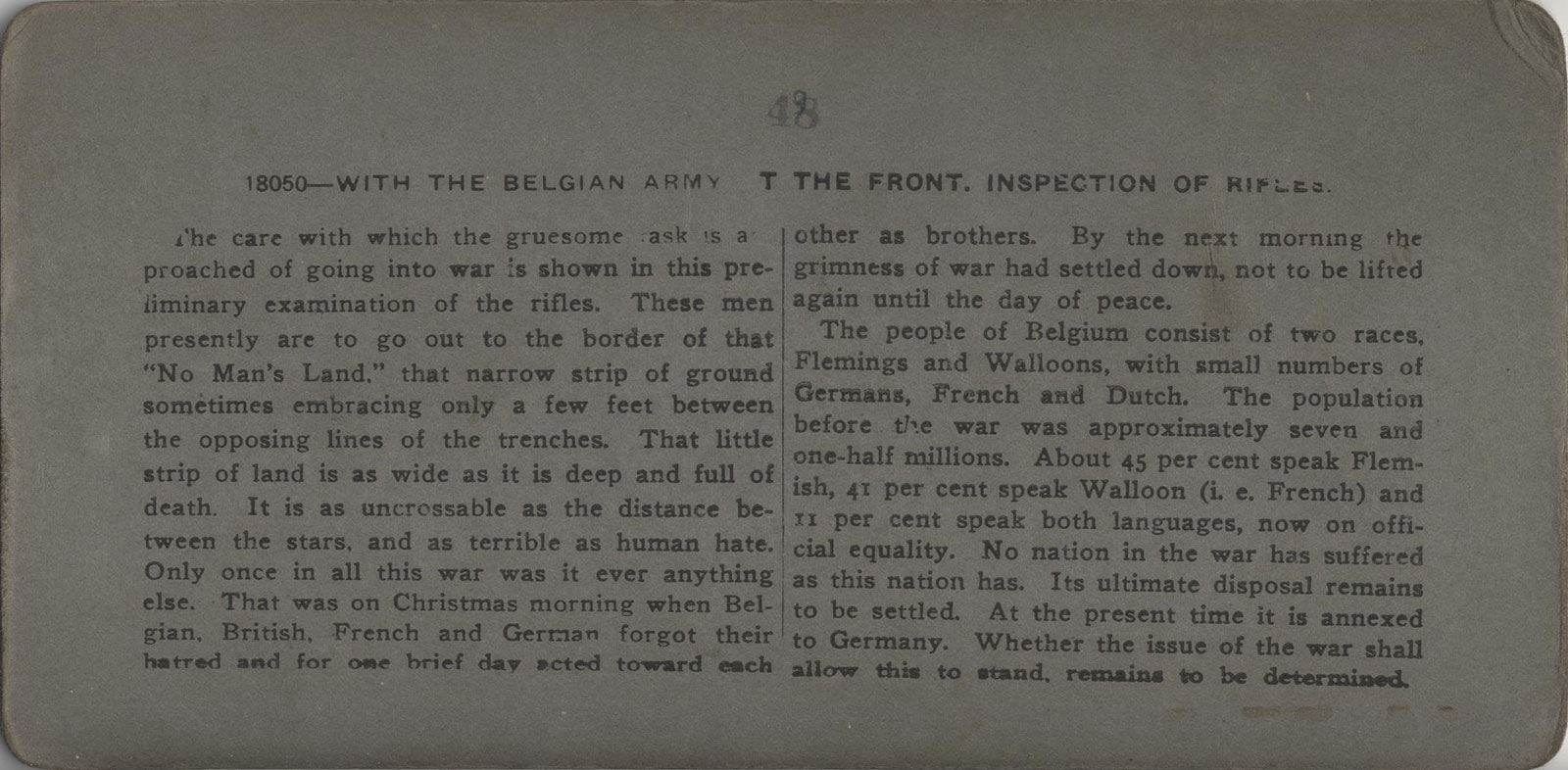At the Belgian Front [1916?]
as keepsakes and to relate current events to the homefront (20).
This stereo card arguably fulfills both roles in that it aims to both memorialize the soldiers and provide an account of life in the trenches. The photograph is close enough that one can recognize individual faces, privileging rather than erasing or devaluing individual identity even as the individual forms a part of the collective (the group of soldiers). This stereograph, unlike many other images of war, depicts soldiers preparing for battle rather than a war-torn landscape or its bloody aftermath. Thus the stereograph draws attention to the war’s human cost, preserving an image of the soldiers even as it foretells their loss (the implication being that many, if not all, of them will not survive). The text on the stereo card’s back, however, is concerned with the general conditions of a soldier’s life: it references No Man’s Land, the Christmas Truce, and the Belgian population. These descriptions are abstract and lack individuality, providing an overview rather than a subjective account. This abstraction may also suggest that the author of the text was never at the front himself.
Sources and Further Reading:
Lenman, Robin. “war photography.” The Oxford Companion to the Photograph : Oxford University Press, 2005. Web. 4 Mar. 2015.
Tucker, Anne, Will Michels and Natalie Zelt. War/photography: Images of Armed Conflict and Its Aftermath. Houston : New Haven: Museum of Fine Arts, Houston ; distributed by Yale University Press, 2012. Print.
In the early years of the war, Britain used the Rape of Belgium for its own propaganda and political purposes. Belgium was a major keystone of British war propaganda, which characterized Britain’s entry into the war as one “to defend small, democratic, neutral countries against autocracy and its supposed by-product, militarism” (Fleming 50). However, though recent scholarship confirms the atrocities of the German occupation, Fleming notes that the “poor little Belgium” narrative is undermined by Belgium’s own atrocities in the Congo and its dubious claim to neutrality (49-50). This political narrative spurred recruitment, anti-German sentiment and attempts to persuade the then-neutral United States to join the war (45-6). Later events, such as the sinking of the Lusitania (55-56) and the Bryce report (52-55), eventually pushed the United States to declare war against Germany in 1917.
However, one cannot ignore the influence of British censorship and propaganda in these cases: Britain cut off any direct communication between Germany and the United States and censored news coming out of Berlin, ensuring that news of the war would be one-sided (44-45). Furthermore, the Bryce report contained sensationalized—and likely fabricated—accounts of German violence in addition to its more accurate descriptions (Fleming 55).
Sources and Further Reading:
Fighting Words and Images Representing War across the Disciplines. Ed. Stephan Jaeger, Elena V. Baraban, and Adam Muller. Toronto: University of Toronto Press, 2012. Print.
Fleming, Thomas J. The Illusion of Victory: America in World War I. New York: Basic Books, 2003. Print.
Kramer, Alan. Dynamic of Destruction: Culture and Mass Killing in the First World War. Oxford: Oxford University Press, 2007. Web. 17 Feb. 2015.
Zuckerman, Larry. The Rape of Belgium: The Untold Story of World War I. New York: New York University Press, 2004. Print.
Perhaps more interesting than the event itself is how the Christmas Truce endures in the public imagination. In wartime, news of the event was generally withheld from official accounts (Eksteins 114) and survives mostly in soldiers’ letters and diaries (95-7). War propaganda, which painted the enemy as barbarians “beyond the pale, incapable of such normal human emotions as compassion and friendship” and some people found the Truce difficult to believe (98). The stereo card certainly emphasizes its unusualness by contrasting it to the (albeit abstractly described) horrors of trench warfare.
In modern times, we memorialize—or even mythologize—the Truce for its romantic and sentimental value. The Christmas Truce has become a hopeful narrative of how peace and goodwill can triumph even in extraordinarily difficult circumstances—one blog article calls it “a Victory for Human Kindness” (Brown 1). More recently, Sainsbury’s, a British grocery store chain, dramatized the event in a Christmas ad. The ad has sparked controversy (Associated Press), with some arguing that it sanitizes the horrors of the First World War and exploits the results for profit. Thus, the issue of what narratives to tell about history, and to what ends we use them, continues to be relevant.
Sources and Further Reading:
Ashworth, Tony. Trench Warfare, 1914-1918: The Live and Let Live System. New York, N.Y: Holmes & Meier, 1980. Print.
Eksteins, Modris. Rites of Spring: The Great War and the Birth of the Modern Age. 1st ed. Toronto: Lester & Orpen Dennys, 1989. Print.
Sainsbury’s. “Sainsbury’s OFFICIAL Christmas 2014 Ad.” Online video clip. YouTube. YouTube, 12 Nov. 2014. 17 Feb. 2015. Available on YouTube
Sainsbury’s.”Sainsbury’s Christmas – The story behind our Christmas ad.” Online video clip. YouTube. YouTube, 12 Nov. 2014. 17 Feb. 2015. Available on YouTube
The Associated Press. “Grocery Chain’s Christmas Ad Stirs Tears, Outrage.” The New York Times 21 Nov. 2014. NYTimes.com. Web. 17 Feb. 2015. Available online


